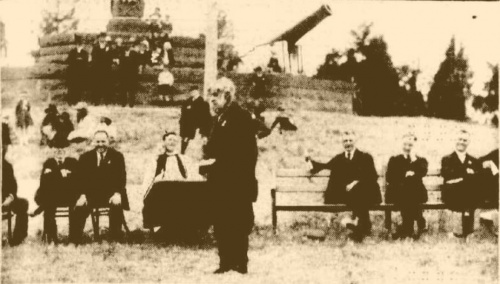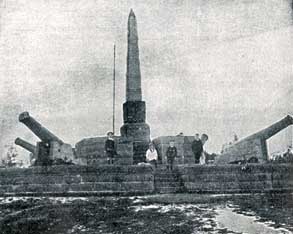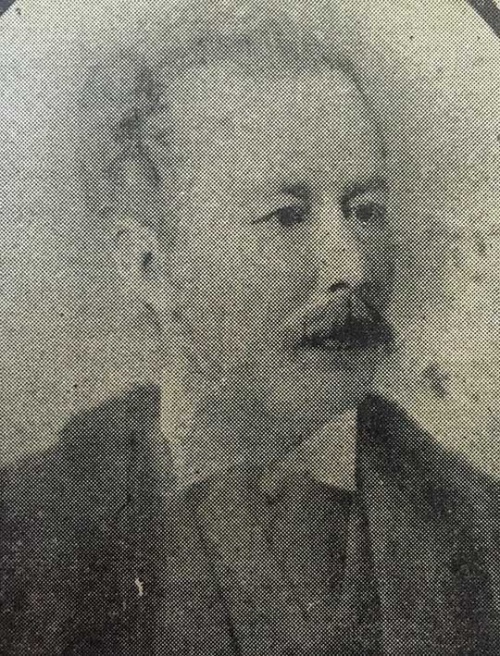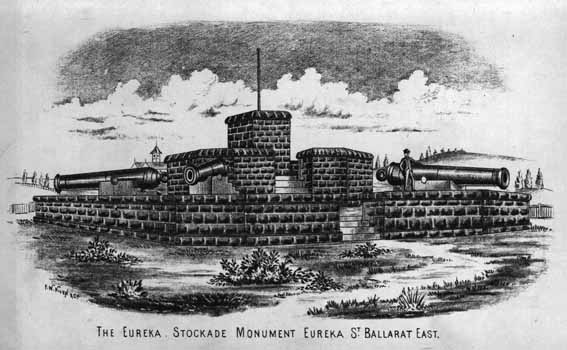Eureka Monument

Contents
Background
On 16 April 1884 the Eureka Stockade Memorial Committee met for the first time. The decided to invite designs for a memorial. [1] The winning design was by H.A. King. [2]
Tender for the erection of the memorial was awarded to Rowsell and sons for the sum of 129 pounds, 18 shillings. On 5 September 1884 the contractor was awarded an further 10 pounds for additional earthworks, with the memorial to be finished by 10 November 1884.[3]
On 25 August 1886 the committee passed to wait on the Ballarat East Town Council on Friday 27 August 1886 for the purpose of handing the memorial over to the Council. [4]
Eureka Memorial Site
1877
"::The Ballarat East Town Council (says the Courier) appears to be determined not to let the Eureka Stockade lie in oblivion any longer, or fade away from the history of Ballarat, for want of some land mark to show the site of the memorable engagement which took place now nearly twenty-three years ago. At the council meeting held last night, Councillor Long moved on notice —"That in the opinion of this council, the spot where the Eureka Stockade once stood, and where so many brave men fell on the memorable 3rd of December, 1854, should be enclosed, as soon as possible, with a substantial tial fence, and a suitable monument erected to the memory of those who lost their lives in resisting tbe unconstitutional proceedings of the Victorian Government, on that occasion." The motion was carried. A motion contingent on this, namely—" That the council pledges itself to set apart at the proper time a sum not to exceed £50, to subsidise any fund that may he raised by the people of Ballarat for that object," was withdrawn for the present.[5]
1884
Thirty years after the Eureka Stockade a monument was to be erected and an attempt was made to determine the exact site that the battle took place..
- On June 26th 1884 several hundred men gathered at Eureka Street and argued. The Star the next day said that the proceedings almost became another Eureka riot. Joseph Roff waving his famous umbrella, ordered that a ring should be formed of those who had been present at the fight and each should give his opinion. [6]
- On 25 July 1884 the committee resolved to inspect the Eureka Stockade Reserve and determine the site for the proposed memorial, and invite the Ballarat East Council to participate. The committee met at Joseph's Hotel, Eureka Street as a diversity of opinion exists regarding the position once occupied by the stockade.[7]
- The great interest taken in everything concerning the Eureka Stockade was evident yesterday, when several hundred persons gathered at the site at Eureka Street, Ballarat East, for the purpose of fixing the exact spot where the fight took place, on which the monument will shortly be erected. Besides a large number of Stockaders and old identities, there were present Messrs James and Russell, M.L.A., Mayor Ferguson and Councillors Lewis, Morrison, Williams, Roff, Gregory, Walker, Scott, Elsworth, and Messrs Bechervaise, J.N. Wilson, H. Josephs, Lester, C. Dyte, D. Turpie and Mr H.A. King, the architect. Mr James Esmond, the gold discoverer, who looked very well, was amongst the Stockaders present. It soon became apparent that great difficulty was in the way of setting down the exact boundaries of the Stockade, which measured about 400 feet in diameter, This was on account of the great change in the surface, the neighbourhood having undergone considerable change in the course of thirty years. Each knot of Stockaders was of a different opinion, and the scenes were rather amusing, as each one stuck stubbornly to his opinion. the memorial committee recognised the difficulty, but had not foreseen anything of the sort, no arrangement had been made to take evidence on the point. Ultimately Councillor Roff exclaimed - "Let us make a ring and get the different opinions." This idea was carried out. Mr James, M.L.A. said that he had come to the conclusion that the Stockade was to the north of the Eureka Street rise. there were cries of 'No, No." Nearly all the remaining diggers were of the opinion that the fight took place about 200 yards to the north of Eureka Street, and ultimately the spot which is about 200 yards to the east of what was generally accepted as the site, was set down as the centre of the Stockade. Mayor Ferguson duly made the announcement, which was received with cheers. The sport selected, even if not actually the exact site of the Stockade, was undoubtedly the most suitable for the monument, which will probably be unveiled on the 30th anniversary in December next. About 50 pounds is still required for the completion of the monument. it is not generally known that 12 acres in the neighbourhood of the Stockade has been declared a reserve, The whole, or a portion of this reserve, will shortly be fenced in by the Town Council.
- Mr C. Dyte pointed out the site of the store he was keeping at the time, and Mr Lester, of Lester's Hotel, indicated the precise locality of an hotel he was keeping in those days. Diversity of opinion was great as to the sites of the Albion Hotel, the blacksmith's shop, and other notable buildings at the time of the stockade. ... the circle was by this item completely broken up and Cr Roff's ambition to form "another circle" was once more put to the test. At this stage, however, calls were made that a "few practical men" had fixed upon the site for the memorial and the place was surrounded. The Mayor of the Town then asked for an expression of opinion to the question whether it was the centre of the Stockade. A few dissentient voices alone were raised. A peg was into the ground to mark the spot, and three rousing cheers were given by the spectators. The memorial will, therefore, be placed in a commanding position, some 30 or 40 yards way from Eureka Street. The design for the monument has been prepared by Mr H.A. King, who is now engaged in preparing specifications of the work. Tenders will be called in a few days, to be dealt with at a meeting of the Committee next week. The sum of 170 pounds has been obtained, mostly in small subscriptions; and the committee are 30 pounds short of the required amount for the erection of a memorial. The angles of the Stockade will be mounted with cannon, donated for the purpose by the Service Government.
- THE EUREKA STOCKADE MONUMENT
- TO THE EDITOR
- Sir, - My heart warms to the writer of your letters on the Eureka Stockade, as I avail myself of the pleasure of perusing his lucid, truthful, and intelligent communications. My tent was near the Stockade, and with a friend I had my share of the perils and dangers of the occasion, and witnessed part of the massacre. I remember, remarking while standing at our tent door, looking upon the work of blood, which we were so powerless to prevent, “we had better go inside, or we might share the same fate;” and inside we went, after having heard the testimony of a youth, who had escaped with his life, as to what had occurred within the Stockade. Some time after I went and inspected the spot, and counted 22 dead bodies; and such a scene, God grant I may never witness again. I judge it is not only a case of “shedding human blood,” but of oppression, tyranny, and massacre; and a fitting monument is needed to testify of these and people’s loyalty and patriotism, and of their justification in resisting the work of the tyrants. If the committee will take this stand, and resolve to raise £2500 for such a monument as I indicated in my former letter, I will contribute £500 towards the amount, every pound to carry a vote, and the form of monument, inscription, and site, to be approved by the Honourable the Speaker of the Legislative Assembly. It would doubtless, be gratifying to those who wish to hide or forget their part in the business that the facts of the time be buried in forgetfulness, but history repeats itself, and it is necessary, both as a matter of justice to the dead and the living who escaped death and to posterity, that the history of the time should live vividly in the memory of the nation, and that periodically the facts should be reviewed and the memory of the slain, and the wounded living be kept green in the minds and affections of the people of Victoria and of all Australia than whom Her Most Gracious Majesty has not, in her vast realm, a more loyal and patriotic people. I hope the committee will see that the experience meeting of men who know of the Stockade takes place. If rightly handled, it will be a tower of strength to the movement, and to history, and I shall be glad to contribute my part. Ample time and notice will bring together such a gathering, and such a testimony as will move the hearts and loving sympathy of the people to a holy appreciation of the loyalty and patriotism of those who resisted unto death. At least 30 are known to have met their death, and it is fair to infer that, being mostly men in the full vigour of manhood, they would have survived until today. Well, now estimate the value of the labour of these 30. Supposing they had lived and earned £2 per week during the 30 years, that would amount to £90,000. But among the living who were in the Stockade, I know one man who is worth £60,000, made since the death of his fellows, and doubtless there are more of the kind. Surely the memory of the men who sacrificed life and the friends who would have shared in the blessings of the £90,000, and the happy homes that would have been made, claim the affection of the living who escaped death, and of the nation; and the least we can do is to honour their memory by a suitable monument. This is a cold view of the humanity of the case; still it has its telling aspect. I therefore appeal to the co-patriots of the noble dead to join heartily in the movement, and participate in the luxury of renewing old friendships, and realising the pleasure that will follow the discharge of a holy duty. But I fear that the mild position the committee have taken will not commend itself to the men of action of December, 1854. I do not admire the reply of the chairman of committee to the friends at Learmonth. He should have taken higher and holier ground. He had no doubt forgotten that those same friends once refused to have a railway made to Learmonth, a unique refusal, singularly original and the only one of the kind to be found in the history of railways all over the world. In the event of the committee not being in a position to claim the sum I have named, it is probable that men who know something of the Stockade, will follow with a movement to complete the work as suggested previously by me. My offer will be a standing one until the monument is erected. One of the wealthy ones is at present away in Europe, and a very likely person to help materially with a considerable sum.
- Yours, &c., MUNICIPAL FREEDOM[8]
1889
- The Eureka Stockade monument Ins now been finished. An obelisk of Stawell freestone, about. 15 fc« t in height, has brren crrcted on the bluortone base, and the mom* meat n->w presents a very much unproved appearance. The four guns, with their carriages, have all been placed in position — one at each corner of the monument. The only inscription on the monument is to be— " Eureka Stockade, December 1S54." The bluestooe obelisk, which was at first proposed to bo placed at the monument, (says the Post) now to be erected on the spot where gold was first found in Ballarat, whenever this spot has been settled upon.[9] (Editors note: The monument is on the site of the Eureka Stockade, not the gold discovery site.)
64-Pound Cannons
The four 64-pound cannon were a later addition, and were provided by the government. [10] They have no connection to the Eureka Stockade.
In The News
- EUREKA STOCKADE MEMORIAL.
- A meeting of the executive committee was held on Tuesday evening; Mr R. Lewis in the chair. Present,— Messrs Ferguson, Bechervaise, Josephs, Williams. Roff, Spain, Morrison, Hall, Dyte, and Wilson. Donations were received from the following mining companies: Royal Saxon, Maxwell’s, New, Britannia, Kong Meng, and Imperial; also; Australian Natives' Association, Ballarat, Creswick, and Stawell branches; Buninyong Miners' Association, St. John's Church Improvement Society, Tinsmiths’ Society,: Typographical Society; from Messrs Wanliss, Wilson, Serjeant, McGovern, M’Donald, Salter, Oddie, Russell, Glenn, Lieutenant-Colonel Smith, Hickman, Ferguson, Hill, Fincham, and others. Poetic contributions from J. W. Mills and William Walker, of Ballarat; and William Rankin, of Craigie, were received with thanks. Seven designs for the memorial were submitted; those marked “Piper," King," and “Pioneer" were highly approved of, and ultimately the design of Mr H. A. King, of Ballarat East, was accepted. It was decided that specifications be prepared, with the view; of calling for tenders forthwith. The committee meet on the ground, in company with the Town Council on Friday, 25th-instant, for the purpose of selecting the site, as there appears a conflict of evidence as to the actual position of the Stockade.[11]
- EUREKA STOCKADE MEMORIAL
- A meeting of committee was held an Tuesday evening. Present—Messrs H. Josephs (in the chair), Wilson, Bechervase, Furguson, Roff, Williams, Hall, and Morrison. A considerable amount of correspondence was read and received. Donations from Messrs Lowenstein, Denovan, Trenworth, Archer, Grubb, Kay, Smith, an old Stockader, Delahunty, and Collins; from Berry Console Company, Bootmakers Union, Golden Stream Company, Mount Rowan Company, Majorca Miners’ Association, town of Clunes, Ironfounders' Union, and Miners’ Association of Ballarat were received and acknowledged. The tender of Rousell and Sons for the erection of platform and base of the memorial was accepted. Mr F.W. Niven was added to the executive committee. The meeting closed with a vote of hanks to the chairman.[12]
- THE EUREKA STOCKADE MEMORIAL.
- The committee of the Eureka Stockade memorial movement and a number of old pioneers, including a number of those who had fought with the diggers on the memorable occasion, assembled on the site of the struggle yesterday afternoon to mark the best place on which to erect a suitable memorial of the event. There was an attendance of fully 200 persons, and many ladies graced the affair by their presence, while the younger generation was also represented in force. Included among those present were Mr John Noble Wilson (chairman of the Water Commission), the mayor of the Town (Mr John Ferguson), Crs Lewis, Morrison, Walker, Gregory, Roff, Williams, Ellsworth, Scott, ex-Crs Turpie and Josephs, Messrs Béchervaise, John and James Robson, Lester, White, C. Dyte, Esmond, Osborne, Hall, Delahunty, Cavanagh, Marks, and several Eureka Stockaders. Messrs James Russell and John James M’s.L.A., also at-tended. The assemblage scattered in different directions over the Eureka, and excited "con-fabs" took place between old identities as to the spots on which the varied scenes transpired in connection with the struggle. Mr C. Dyte pointed out the site of the store he was keeping at the time, and Mr Lester, of Lester's hotel, indicated the precise locality of an hotel he was keeping in those days. Diversity of opinion was great as to the sites of the Albion Hotel, the blacksmith's shop, and other notable buildings at the time of the stockade. It was evident that the memory of the struggle and the causes that led up to it were still green in the hearts of many an old pioneer, and nothing seemed to give them greater pleasure than to give information to the young people regarding the occurrence. However, while willing to afford facilities to the young men to acquire knowledge on this head the old pioneers could not agree with each other as to the precise locali-ties of the events themselves. Sometimes it seemed as if another "riot" was inevitable, and that the aid of the police would have to be called in, the military in these days being out of the question. One man could tell the exact boundaries of the Stockade, because he was aware of the spot on which his tent stood, near at hand, it being there his wife presented him with their eldest born son. Mr C. Dyte waa very much interested in showing the spot where the "Jew gingerbeer man" was found beneath the slabs with nine bullets imbedded in his body. Others sought to identify the site of the Stockade by the line of march of the soldiers on their way to attack the insurgent diggers. Others again fixed the locality by the site of the blacksmith's shop, where the smith with brawny arms hammered out iron for the manufacture of pike-heads, the smith himself afterwards receiving the testimony of the soldiers' advance by the deadly contact of a bullet with his forehead. Mr Delahunty, who now resides at Buninyong, also had his say to this effect:— The night before the attack he was standing sentry, and had received orders from Arthur Vern to shoot any man who attempted to pass out of the stockade. He in common with others was told at midnight by a certain captain to "turn in," which he did. Some time in the morning when the firing began he rushed out of his tent, and as it was dark he made for the "Nottingham tree," which had, however, been cut down. He then found Peter Lalor, and assisted the latter to a tent where another wounded man lay. Then Delahunty went back into the stockade and fetched "Father Smith" to attend to Lalor. Mr Delahunty was confident that he could fix the site of the struggle beyond question. Matters seemed to be approaching to a crisis, and as refreshments were not provided ad lib on the ground propositions for sundry adjournments for whisky, lemonade, ginger ale, and hop bitters were mooted, until the chairman of the committee (Cr Lewis) rose to the occasion and suggested that the veteran stockaders should gather in a circle, and one at a time to express his opinion as to the real site. Cr Roff, with one or two henchmen, was indefatigable in gathering in the "devoted few," and by wildly flourishing his umbrella the councillor in question did succeed. The gra-vity of a council of Red Indian braves and warriors, as described by Fenimore Cooper, did not prevail. An eager, anxious throng, suggestive of a railway deputation, all wished to speak at once, and notwithstanding the gesti-culations and "Order, order" of Cr Roff and oily eloquence of the chairman, order could not be maintained. The excited thoughts of other days surged through the brains of Old Pioneers. and each wished to be heard. Above the din Cr Lewis' voice could be distinguished asking "Are we in the boundaries of the stockade?" Cries of "Yes, yes," "No, No," "You're wrong," "Will you be quiet?" "Keep your temper." At this stage a few practical men accompanied Mr Esmond and others to a place which they said was the best and proper site on which to place the monument, viz., in the centre of the ground. Mr John James, M.L.A., then informed the other crowd that he and his wife had walked up to the Eureka that day in order to show definitely the spot. He graphically described the site of his tent in those days, and described how the bullets whistled round the tent to the danger of him-self, wife, and children. After the firing had ceased he and his wife went out and saw the stockade inflames, and also the wounded men. The applause which greeted this portion of his speech must have been as "balm of Gilead," to Mr James, and he wanted it as shown by his concluding remarks. The universal opinion was that the stockade was situated to the north of Eureka street, but Mr James' claim that it was on the southern side of the road, was received with strong expressions of dissent and laughter. The circle was by this time completely broken up and Cr Roff's ambition to form "another circle" was once more put to the test. At this stage, however, calls were made that the "few practical men" had fixed upon the site for the memorial and the place was surrounded. The Mayor of the Town then asked for an expression of opinion to the question whether it was the centre of the stockade. A few dissentient voices alone were raised. A peg was then driven into the ground to mark the spot, and three rousing cheers were given by the spectators. The memorial will, therefore, be placed in a commanding position, some 30 or 40 yards away from Eureka street. The design for the monument has been prepared by Mr H. A. King, who is now engaged in preparing the specifications of the work. Tenders will be called in a few days, to be dealt with at a meeting of the committee next week. The sum of £170 has been obtained, mostly in small subscriptions; and the committee are £30 short of the required amount for the erection of the memorial. The angles of the stockade will be mounted with cannon, donated for the purpose by the Service Government.[13]
Other Sites
http://vhd.heritage.vic.gov.au/vhd/heritagevic#detail_places;125351
Also See
Eureka Stockade Memorial Committee
References
- ↑ Chisholm, J.A., A few notes o the site of the Eureka Memorial, 1974.
- ↑ Butters, Peter, Monument to Eureka IN Ballarat Courier, March 2000.
- ↑ Chisholm, J.A., A few notes o the site of the Eureka Memorial, 1974.
- ↑ Chisholm, J.A., A few notes o the site of the Eureka Memorial, 1974.
- ↑ Melbourne Advocate, 13 October 1877.
- ↑ Spielvogel, Nathan, Spielvogel papers, Vol. 1, Ballarat Historical Society, 1974.
- ↑ Chisholm, J.A., A few notes o the site of the Eureka Memorial, 1974.
- ↑ Ballarat Star, 21 June, 1884.
- ↑ Geelong Advertiser, 19 March 1889.
- ↑ Butters, Peter, Monument to Eureka IN Ballarat Courier, March 2000.
- ↑ Ballarat Star, 16 July 1884.
- ↑ Ballarat Star, 20 August 1884.
- ↑ Ballarat Star, 26 July 1884.
--Clare K. Gervasoni (talk) 17:11, 15 March 2013 (EST)





